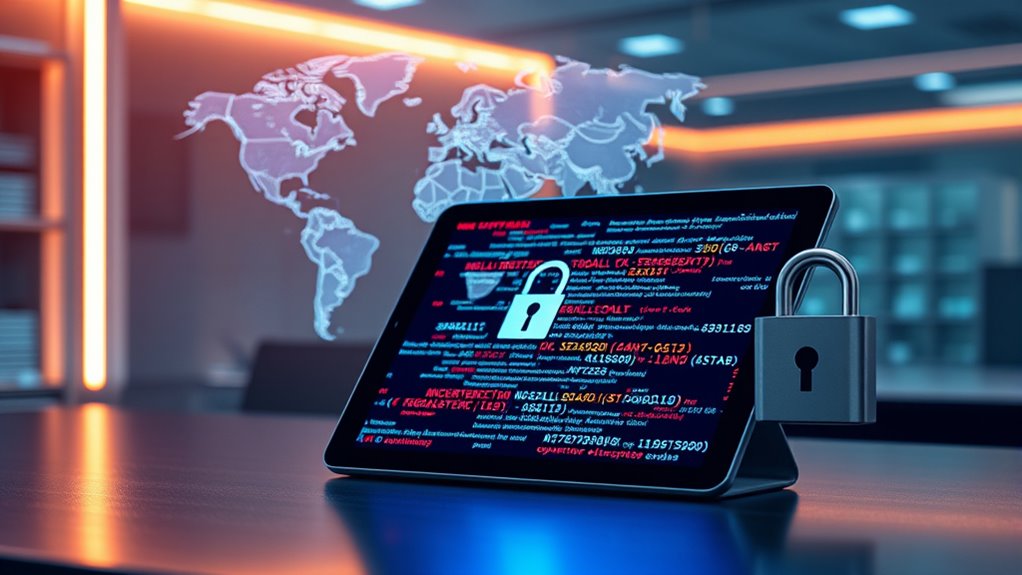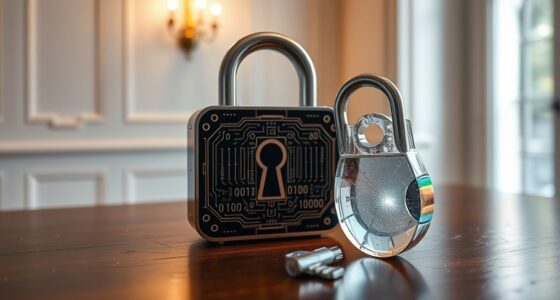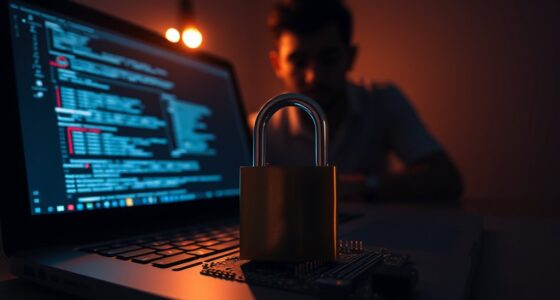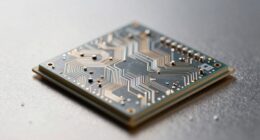As a business, you need to understand that quantum computers could soon break current encryption methods, putting your data at risk. Post-quantum algorithms, like lattice-based, code-based, and hash-based schemes, offer ways to protect your systems against this emerging threat. Quantum-safe cryptography depends on complex mathematical problems that quantum computers can’t easily solve. To stay ahead, it’s essential to explore these options further, which can help secure your future in a post-quantum world.
Key Takeaways
- Post-quantum algorithms, such as lattice-based and hash-based methods, provide security against future quantum computer threats.
- Transitioning to quantum-safe cryptography is essential for protecting sensitive business data and maintaining trust.
- Understanding the differences between quantum cryptography and quantum-resistant algorithms helps choose appropriate security solutions.
- Industry standards and regulations are evolving to guide organizations in adopting quantum-resistant security measures.
- Implementing quantum-safe cryptography requires planning for infrastructure updates, compatibility, and ongoing security assessments.
Understanding the Need for Quantum-Resistant Security

As practical quantum computing advances, the threat to data security becomes more immediate, especially for financial institutions. Quantum computers can break current encryption methods, exposing sensitive customer data and risking financial losses. Ignoring these threats could lead to data breaches and damage trust in your organization. Governments have set deadlines, like 2035 for federal agencies, to ensure systems become quantum-resistant. By proactively adopting quantum-resistant algorithms, you protect communications and uphold industry integrity. These vulnerabilities stem from quantum algorithms such as Shor’s, which efficiently factor large numbers, threatening RSA and ECC encryption. Grover’s algorithm also speeds up attacks on symmetric hash functions. Quantum algorithms like Shor’s can break current encryption standards, emphasizing the urgency of transitioning to secure, quantum-resistant systems. Recognizing the importance of quantum-resistant algorithms is crucial for maintaining long-term data security as quantum technology continues to evolve.
How Quantum Computers Threaten Current Cryptography

Quantum computers have the potential to break widely used cryptographic systems by leveraging their unique processing capabilities. They use qubits that process multiple states simultaneously, vastly surpassing classical bits. With algorithms like Shor’s, quantum computers can efficiently factor large numbers, threatening RSA and ECC encryption, which rely on the difficulty of such problems. This directly endangers internet security, digital signatures, and key exchanges. This potential vulnerability could compromise data confidentiality, authentication, and trust, especially in sectors like finance, healthcare, and government, where secure data is critical. While practical, large-scale quantum computers don’t yet exist, experts don’t expect them within the next decade due to technical hurdles. However, the threat remains because adversaries could harvest encrypted data now for future decryption. Quantum computing’s rapid development could accelerate this risk significantly. This emerging technology also emphasizes the importance of developing post-quantum algorithms to safeguard digital information against future quantum attacks.
Exploring Different Types of Post-Quantum Algorithms

You should consider the variety of post-quantum algorithms available, each with unique strengths and challenges. Lattice-based methods like CRYSTALS-Kyber and Dilithium offer efficient and standardized options, while code-based schemes provide strong security against quantum attacks. Hash-based and multivariate approaches also play essential roles, balancing simplicity and security in the evolving landscape of quantum-safe cryptography. Ongoing standardization efforts are crucial to ensure these algorithms are reliable and widely adopted in the future. As research advances, quantum-resistance mechanisms continue to evolve, highlighting the importance of staying informed about emerging developments.
Lattice and Code Cryptography
Lattice and code cryptography represent a promising class of post-quantum algorithms that leverage complex mathematical structures to secure data against future threats. You work with high-dimensional lattices formed by linear combinations of vectors, making calculations difficult for attackers. The security depends on hard problems like finding the shortest vector or learning with errors, which remain tough even for quantum computers. Practical implementations use thousands of dimensions, increasing complexity and security. Here’s a quick overview: hard mathematical problems
| Algorithm/Problem | Purpose/Use Case |
|---|---|
| LWE | Noise-based encryption and security |
| SIS | Digital signatures and one-way functions |
| Ring-LWE | Efficient polynomial ring variants |
| NTRU | Practical lattice encryption schemes |
| Security | Resistant to quantum and classical attacks |
Hash and Multivariate Methods
Hash-based and multivariate cryptography represent two distinct approaches to achieving quantum-resistant security. Hash-based cryptography relies on the difficulty of preimage resistance in hash functions to create secure digital signatures. These schemes, like SPHINCS+, are well-studied and resistant to quantum attacks, although they often have large signatures and keys. In contrast, multivariate cryptography uses systems of multivariate polynomial equations over finite fields, which are NP-complete to solve. This makes them highly resistant to both classical and quantum attacks. Schemes like Rainbow and UOV offer smaller signatures but tend to have larger keys. Both approaches are actively researched, with hash-based schemes primarily used for signatures and multivariate schemes showing promise for efficient key exchange and digital signatures in a post-quantum world. Multivariate cryptography’s NP-completeness provides a strong theoretical foundation for its security against quantum adversaries. Additionally, ongoing research aims to improve the efficiency and practicality of these algorithms to make them more suitable for real-world applications.
Differentiating Between Quantum Cryptography and Quantum-Safe Methods

You should understand that quantum cryptography relies on the principles of quantum physics to secure communication, using phenomena like entanglement for key exchange. In contrast, quantum-safe methods depend on mathematical algorithms designed to withstand quantum attacks, running on classical hardware. Recognizing this difference helps you evaluate which approach best fits your security needs and infrastructure. Quantum cryptography typically requires specialized hardware and infrastructure, making it more costly and complex to deploy at scale. Additionally, understanding the fundamental principles of quantum physics involved can help clarify why these methods differ in implementation and security guarantees.
Quantum Mechanics Security
Quantum cryptography and quantum-safe methods both aim to protect data against emerging quantum threats, but they do so using different principles and technologies. Quantum cryptography relies on quantum mechanics, specifically using qubits to encrypt and decrypt messages, ensuring security through physical laws. It offers secure key exchange via Quantum Key Distribution (QKD), which can detect eavesdropping but requires dedicated hardware and channels. Quantum-safe methods, on the other hand, focus on algorithms resilient to quantum attacks, like those based on complex mathematical problems—these include post-quantum cryptography (PQC). PQC is compatible with existing infrastructure and highly scalable, making it suitable for widespread use. While quantum cryptography leverages physical principles for security, quantum-safe algorithms depend on mathematical complexity to withstand quantum computing threats. Furthermore, quantum-safe algorithms are designed to be implemented in software, facilitating easier integration into current systems without the need for specialized hardware.
Algorithm vs. Physics
Understanding how quantum cryptography and quantum-safe methods differ begins with their foundational principles. Quantum cryptography relies on physical phenomena, like quantum mechanics, to secure data and detect eavesdropping. In contrast, quantum-safe methods depend on mathematical algorithms resistant to quantum attacks, making them adaptable to existing infrastructure. Quantum-safe cryptography is designed to be compatible with current network systems, enabling a smoother transition as quantum threats evolve.
| Quantum Cryptography | Quantum-Safe Methods |
|---|---|
| Uses quantum physics | Uses advanced algorithms |
| Requires specialized hardware | Can run on current systems |
| Detects eavesdropping | Focuses on algorithm security |
| Based on physical principles | Based on computational complexity |
| Limited infrastructure | Widely deployable |
This distinction shapes their implementation, strengths, and challenges in securing future communications.
Challenges in Implementing Quantum-Resistant Solutions

Implementing quantum-resistant solutions presents a range of significant challenges that organizations must navigate carefully. The complexity of post-quantum algorithms means they’re not fully analyzed, increasing the risk of undiscovered vulnerabilities. Their mathematical intricacy can lead to unforeseen flaws, sometimes only identified years after deployment. Continuous testing is essential to guarantee security. Larger key sizes and more intensive computations slow systems and strain memory, especially in low-power devices. Compatibility issues arise when upgrading infrastructure, requiring hardware, software, and protocol updates, often complicating hybrid environments. Scalability remains problematic—many algorithms struggle to maintain security at scale, risking vulnerabilities. Additionally, as quantum computers grow stronger, PQC algorithms might become vulnerable, demanding ongoing adaptation. Ongoing research and standardization efforts are essential to ensure long-term security, as the pace of quantum computing advancement accelerates. Moreover, collaborative industry efforts are crucial for developing robust standards and best practices. Balancing security, efficiency, and compatibility remains a core challenge for organizations adopting quantum-resistant solutions.
The Future of Quantum-Safe Cryptography and Industry Standards

As industries worldwide prepare for the imminent rise of powerful quantum computers, establishing robust standards for quantum-safe cryptography becomes essential. Governments and organizations are finalizing regulations and frameworks, such as NIST’s standards in 2024-2025 and the EU’s cross-sectoral PQC roadmap. These efforts guarantee harmonized implementation, covering encryption, digital signatures, and hardware security. Your industry must adapt quickly to meet deadlines like the US security sector’s 2030 compliance goal and incorporate PQC into supply chains, devices, and infrastructure. Implementing these standards early will help mitigate risks associated with quantum threats and ensure a smoother transition.
- The adoption of new standards influences certification and trust for vendors and products.
- Industry collaboration is crucial to address interoperability during the transition.
- Continuous updates and real-world testing will shape future guidelines and best practices, emphasizing the importance of standardization efforts to promote consistency and security in the evolving landscape.
Preparing for a Post-Quantum World: Strategies and Best Practices

Preparing for a post-quantum world requires strategic planning and proactive risk management. You should develop all-encompassing strategies to address quantum threats, focusing on how quantum computing impacts current cryptography. Conduct vulnerability assessments to pinpoint which systems and network layers are most at risk. Prioritize the protection of high-value assets and critical infrastructure that could suffer severe damage if compromised. Test post-quantum cryptography (PQC) implementations to assess performance, compatibility, and security. Enhance cryptographic agility to allow quick adaptation to evolving standards. Design modular, upgradable hardware and software systems, and plan operational procedures for both remote and physical updates. Regularly audit your cryptographic infrastructure, classify sensitive data, and coordinate with stakeholders, regulators, and suppliers to stay ahead of emerging PQC standards and best practices. Implementing comprehensive inventory management is essential for understanding where cryptographic algorithms are deployed across your organization. Additionally, staying informed about emerging cryptography standards can help ensure your organization remains compliant and resilient in the evolving landscape.
Frequently Asked Questions
How Soon Will Quantum Computers Realistically Threaten Existing Security Systems?
You’re wondering when quantum computers might threaten your security systems. Based on current estimates, there’s a 17% chance by 2034 that a quantum computer could break RSA 2048 in a day, rising to 79% by 2044. Many organizations and governments are acting now, with deadlines by 2030 or 2035, to upgrade to quantum-safe cryptography. Staying informed and proactive helps you prepare before the threat becomes imminent.
Are Quantum-Safe Algorithms Compatible With Current Hardware and Software Infrastructures?
Think of your infrastructure like an old car needing a tune-up. Quantum-safe algorithms are becoming more compatible, but they demand more power—like upgrading the engine. Your current hardware can run some PQC algorithms with software tweaks, but older devices may struggle without upgrades. Specialized hardware and hybrid systems help bridge the gap, making quantum safety a feasible step forward, even if it’s not a perfect fit yet.
What Are the Main Differences Between Quantum Cryptography and Post-Quantum Cryptography?
You’re asking about the main differences between quantum cryptography and post-quantum cryptography. Quantum cryptography uses quantum mechanics principles and specialized hardware to secure communication, offering theoretically unbreakable security and eavesdropping detection. Post-quantum cryptography, on the other hand, relies on classical algorithms that resist quantum attacks, running on existing hardware and networks. It’s more practical for current deployment, but its security depends on computational difficulty rather than physical laws.
How Do Larger Key Sizes Impact System Performance and User Experience?
Larger key sizes in post-quantum cryptography are like adding weight to a backpack—security gets stronger, but your system feels the strain. You might notice slower encryption and decryption, longer processing times, and increased storage needs. For users, this can mean delays and less smooth experiences, especially on resource-limited devices. To keep performance smooth, you’ll need smarter algorithms and infrastructure upgrades that balance security and usability.
What Organizations Are Leading the Development of Post-Quantum Cryptography Standards?
You should know that NIST leads the development of post-quantum cryptography standards, setting the foundation for quantum-resistant algorithms. They’ve finalized key standards like CRYSTALS-KYBER, CRYSTALS-Dilithium, and SPHINCS+. The DHS partners with NIST to guarantee government readiness, while industry groups like IETF and companies like Microsoft work on integrating these standards into real-world systems. Cryptographers worldwide also contribute to researching and evaluating new quantum-safe algorithms.
Conclusion
As you prepare for a post-quantum world, stay informed, stay adaptable, and stay proactive. Embrace evolving technologies, understand emerging threats, and implement robust solutions. By doing so, you’ll protect your data, secure your systems, and build resilience against future challenges. In this rapidly changing landscape, your vigilance, your innovation, and your commitment to quantum-safe practices will determine your success. Stay ahead, stay secure, and turn uncertainty into opportunity.









